|
|
NEW ECHOTA |
|
|
|
|
|
NEW ECHOTA |
|
|
|
|
|
|
|
New Echota is one of the most significant Cherokee historical sites in the nation. The fate of the Cherokee people and our homeland hinged on the validity of the Treaty of New Echota, signed by candlelight on the night of December 29, 1835 by a handful of Cherokee leaders, none of whom had the elected authority to do so. Perhaps the absence, or dismissal, of the treaty would have changed nothing. We will never know. As we explore New Echota, you will hear the story of what did happen. Maybe we can learn both about and from it. Like the symbol of the Phoenix rising up, all of us benefit. We can acknowledge the truth, the mistakes, the injustices . . . . . . . then we can forgive. Though my Cherokee connection is seven generations past (I have been known to joke if I sneezed too hard I could lose it altogether), I am writing this in a first person possessive style, for this has become my story over these last thirteen years, since I was called to this path as a part of my spiritual journey. I visited New Echota for the first time on March 27, 1998 (picture rolls 426 thru 429) with my son, Christopher, while we were visiting relatives in the south. I returned on February 18, 2000 (picture rolls 550 thru 555) with my wife, Donna. I returned once more, alone, January 12, 2005 with my digital camera (D752 files) to find they had significantly changed the museum display area. You will see a mix of images from all three trips. Although these will be the most extensive scrapbook photos pages I have done to date, nothing compares with walking the ground where it all took place. If you can, definitely visit New Echota, particularly if you have any Cherokee heritage at all. For the rest of you, my tour may need to suffice. Come, we will use the Self-Guiding Trail map provided. |
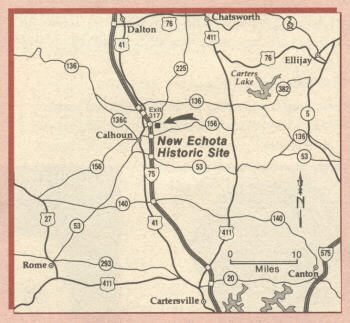 New Echota is located north of Atlanta, Georgia, just off I-75. It is not too far from the Chief Vann House (one of my first scrapbook photos pages). |
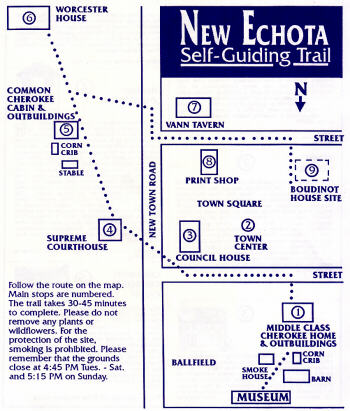 |
|
|
Before we enter the museum we will look at some of the signage by the entrance to the site and the museum. If this were a continuation of the SGT map (above right), the highway we came in on would be about where the first line of this text is. After driving past the entrance sign (opening photo) we notice an historical marker pointing across to the other side of the highway. |
|
|
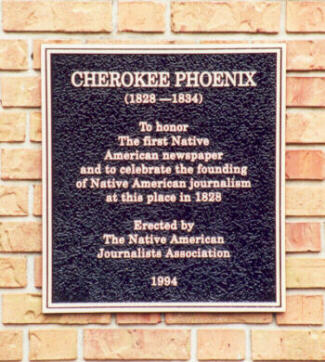 The inset in the monument photo at left is from 2000. The main photo was taken in 2005. Did you notice the difference in the flags? I had not until I was working on these pages. The Confederate Bars & Stars were still flying in 1998 and 2000. |
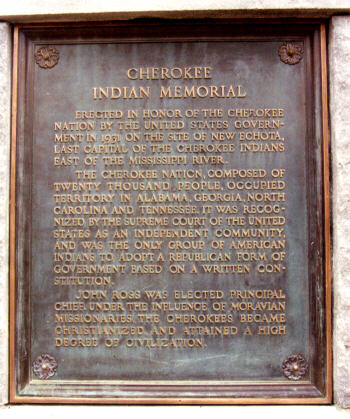 |
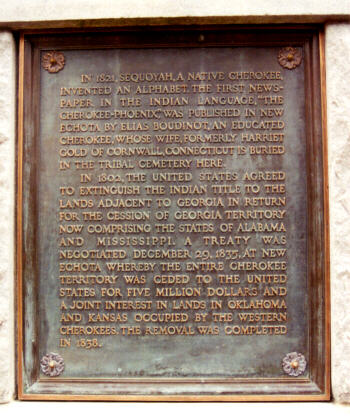 |
|
There are nine stops laid out and described in the SGT brochure/map. Starting in the museum you can exit to each of the nine locations in sequence, or use the picture links below to each page. |
||||
|
|
|
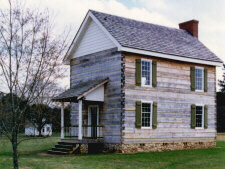 |
||
|
|
|
|
||
|
|
|
|
||
|
At first I thought the name Self-Guiding Trail (the brochure/map) was a little odd sounding. But, I have come to appreciate the subtleties of its use and attachment to these pages. I once wrote, "It is a very worldly and short-sighted belief that winning automatically erases the consequences of any injustices which occurred in the process of reaching victory." Injustice anywhere, in any form, contributes to the darkness of our world. The negative energies from this incredible injustice persist yet. They haunt this land we call the U.S.A. I can feel them lingering inside and around me when working on something like composing these pages. And, although I have written these pages using a first person possessive style, if you are an American, this is as much your history as it is mine. I do not have the answers for the above quote. Repent and forgive are nice sounding words, but we cannot say "we're sorry," then go on mistreating whoever the next group of human beings is which stand in the way of our selfish desires, or personal prejudices. After doing all we asked of them (acculturation and civilized society), and in a time of peace (there was no Cherokee version of a Geronimo or Sitting Bull staging or calling for uprisings, or on the warpath), we required my people to leave their homes and make an 800 mile journey west; cold, hungry, and disheartened, lasting an average of 116 days where many of them died. All because in our greed and prejudice, we still wanted their land and gold. Let me ask you this, were you willing to take the time to walk this entire "trail of tears" with me through these pages? Or, did you skip around or skim over it, because your life is too busy for something as unimportant (or boring) as old history. History you do not necessarily even see as your own, though it is. If so, shame on you. Such an attitude places you among those destined to repeat the tragedies of the past. I do not get paid to do this. Plus, I am not enough Cherokee to derive benefits from casinos or anything else "whites" tend to bring up when speaking about such things. The museum page alone took me in the neighborhood of 40 hours to create (many late nights). This "self-guiding trail" is my way of saying, from this day forward, let the path of greed, prejudice, and injustice not be the American way. Ordinary people let and made it happen. This is our time to make the choices. If you never look at any other of my Scrapbook Photos pages, I hope you will come back to this one as often as you need to as a way of bringing back perspective. A Cherokee leader was supposed to look seven generations back, and seven forward, when making important decisions. I claim no such title, but stand at a seventh generation distance and ask you, though we must forgive, never to forget. |
|
|
|
|
|
|
|
|